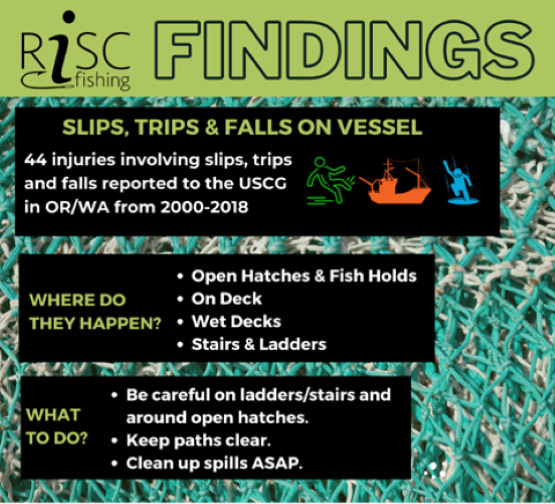
Humans can be amazing. Most of us can stand upright on two feet, walk and move around easily, even gracefully sometimes. It gets harder to walk and do your work when you are out on a rain-soaked dock or moving vessel.
There may be gear or equipment to navigate around. There may be steps or ladders to get from one level to another or from the dock to the vessel. There may be something on the working surface that makes it slippery—rain, ice, saltwater, hydraulic fluid, fish or bait. Not to mention that when you are working on deck, there is fishing gear, tools and equipment in motion and coordination of movement with other fishermen, their gear or activities. There’s also the weather and sea conditions.
By reviewing the reported injury information for Oregon and Washington commercial fishermen from 2000-2018, we found that nearly 20% of the nonfatal and fatal injuries were related to slips, trips or falls.
For the nonfatal injuries, most were falls that happened on deck. Of the fatalities, which were falls overboard, 35% were related to a slip/trip on the deck, while 29% were related to being knocked by gear or entangled in the gear. None of crew members in the fatal falls overboard were wearing a personal flotation device or PFD.
Slips, trips and falls are not unique to the Pacific Northwest, since fisheries in other regions also experience a high number of fatal and nonfatal injuries due to hazards on the vessels. You do not have to fall for it. There are ways fishermen can reduce the risk of slips, trips and falls, including preventing falls overboard, and increasing the chances of walking away from an incident.
Let’s go over housekeeping—or should we say vessel-keeping?
- Organize your gear or equipment so it is secure and not in the way where the fishermen need to work.
- Wear shoes that provide good traction. Check your treads and replace shoes if the tread is worn or separated.
- Apply traction tape in high-traffic areas or have slip-resistant mats. Be sure that any mat or surface does not create more hazards by considering their placement and use.
- Navigate your path. Plan your actions and ensure your path is clear.
- Coordinate your work and be aware of what the other crew are doing so you do not hit them and they do not hit you with gear.
- Clean up spills and slippery surfaces as soon as you can.
If you can prevent slipping and tripping on the vessel, you’ll help prevent a fall overboard. Here are some additional considerations for your vessel and preparation that can help prevent and reduce the impact of falls overboard.
- Create a more enclosed workspace, raise the gunnels or use lifelines and tethers where possible.
- Watch out for your crew—keep an eye out to witness any fall overboard or have a man-overboard alarm for crew.
- Identify a PFD (personal floatation device) that works for you—maintain it and wear it.
- Have and practice recovery plans, including equipment used to rescue victims.
- Have your CPR and first-aid skills up to date so once you rescue a crewmate, you can resuscitate and treat the person.
The Risk Information System for Commercial (RISC) Fishing provides short summaries of RISC Fishing Findings like the one pictured here for slips, trips and falls as well as hazard sheets for various commercial fishing activities.
By considering your situation and the activities you have planned, you consider the hazards and what you can do to reduce your risk of injury.
